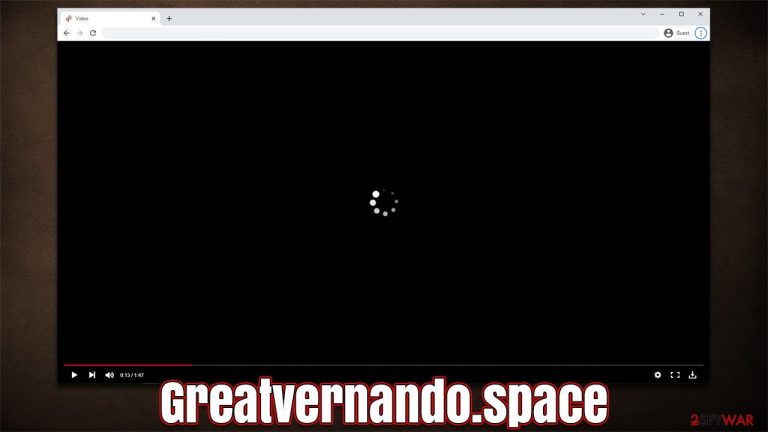Greatvernando.space ads (Free Instructions)
Greatvernando.space ads Removal Guide
What is Greatvernando.space ads?
Greatvernando.space is a rogue website that uses misleading messages to reach its goals

Greatvernando.space is a scam website that employs various tricks in order to make users subscribe to push notifications, only to exploit this later. Users usually unintentionally venture to this website after clicking a booby-trapped link or are taken by automatic scripts (clicking on an empty page's space, for example). Alternatively, redirects to phishing,[1] scam, spoofing,[2] and similar malicious websites might be a sign of adware infection, as those affected are more likely to encounter unsafe material online.
Once Greatvernando.space is reached, users are then presented with something that usually looks like a verification page. Visitors might be asked to confirm that they are not robots or that they have won an expensive gift. The message is commonly accompanied by a matching image, e.g., a fake picture of a video player that resembles YouTube's one.
In order to seemingly get the rewards, users are asked to press the “Allow” button within the notification prompt. However, as soon as that is done, they realize that there is no video to see and no further content to explore. Instead, people are redirected to similar misleading or dangerous websites, for example, Captcha4greatpeaple.top, Notificationstech.com, or Rplnd23.com. We recommend not interacting with these websites and closing down the browser tab immediately.
The activity does not come to users' screens for a while after they allow Greatvernando.space to show notifications. This is precisely the main reason why many people can't connect these occurrences and struggle with pop-up removal. Below we will provide all the details needed to stop the intrusive activity for good.
| Name | Greatvernando.space |
| Type | Push notifications, ads, pop-ups, scam |
| Distribution | The entry point is via the notification prompt – users need to press the “Allow” button |
| Symptoms | Intrusive pop-ups show up directly on the desktop, on top of all other opened apps or websites |
| Risks | Monetary losses, installation of potentially unwanted programs/malware, personal data leak |
| Removal | Access browser settings to stop intrusive push notifications. After that, make sure that your system is not infected with adware or malware – scan it with SpyHunter 5Combo Cleaner |
| Recovery | Potentially unwanted programs often leave traces within web browsers – cookies, for example, are used for tracking. You should get rid of these leftovers with FortectIntego or employ our manual guide |
What are push notifications?
Push notifications might seem identical to ads that one might see upon entering a website. Visually, commercial material shown in a pop-up window is something that both advertisements and the push notification feature do, although the operational principles are quite a bit different.
Advertisements are triggered by users' entry to the website and can be either barely noticeable to extremely intrusive. Push notifications, on the other hand, are not triggered by user actions and can be spotted appearing on the desktop on top of all the other running apps at the time.
This happens because the push notifications work on the system level, and they can show up as long as the browser is either being used or is running in the background. It means that, as long as you have your browser fully shit down, the Greatvernando.space pop-ups will not show up.

Watch out: there might be adware installed on your system
There are plenty of malicious websites out there, and you could access one accidentally while browsing the web (keep in mind that visiting torrents and similar high-risk websites increase that possibility by a lot). However, as we already mentioned at the start, adware could be one of the main reasons why Google Chrome or another web browser is actively showing (questionable) ads and delivers links to dangerous websites.
Therefore, we strongly recommend checking the system for adware and possibly other infections – many users are unaware that their devices are infected due to software bundling and similar PUP/malware distribution techniques. The easiest way to ensure your system is clean is by scanning it with SpyHunter 5Combo Cleaner or Malwarebytes security software. If found, all malicious programs and files would be eliminated at once.
Likewise, if unwanted apps or malware were found, you should also clean your web browsers from cookies[3] and other leftover files to prevent data tracking by third parties. You can employ FortectIntego for the purpose or follow the manual guide below:
Google Chrome
- Click on Menu and pick Settings.
- Under Privacy and security, select Clear browsing data.
- Select Browsing history, Cookies and other site data, as well as Cached images and files.
- Click Clear data.

Mozilla Firefox
- Click Menu and pick Options.
- Go to Privacy & Security section.
- Scroll down to locate Cookies and Site Data.
- Click on Clear Data…
- Select Cookies and Site Data, as well as Cached Web Content and press Clear.

MS Edge
- Click on Menu and go to Settings.
- Select Privacy and services.
- Under Clear browsing data, pick Choose what to clear.
- Under Time range, pick All time.
- Select Clear now.

MS Edge (legacy)
- Click on the Menu (three horizontal dots at the top-right of the browser window) and select Privacy & security.
- Under Clear browsing data, pick Choose what to clear.
- Select everything (apart from passwords, although you might want to include Media licenses as well, if applicable) and click on Clear.

Safari
- Click Safari > Clear History…
- From the drop-down menu under Clear, pick all history.
- Confirm with Clear History.

Removal of Greatvernando.space pop-ups explained
Due to the intrusive nature of push notifications, as well as insecure contents within the shown pop-ups, many users might believe that they have been affected by some type of virus. Considering that intrusive ads are commonly a sign of adware infection, it is not surprising that users would come to this conclusion.
However, if you see Greatvernando.space pop-ups continuously, it is not directly related to malware. The activity is a result of you allowing to receive notifications from this website, so you have to access browser settings and deny access. This is not difficult to do, so if you fall victim to a similar scam or accept notifications by accident, you can use these instructions to get rid of them as well.
Getting rid of Greatvernando.space ads. Follow these steps
Stop browser notifications
Remove unwanted notifications from Google Chrome (desktop):
- Open Google Chrome browser and go to Menu > Settings.
- Scroll down and click on Advanced.
- Locate Privacy and security section and pick Site Settings > Notifications.

- Look at the Allow section and look for a suspicious URL.
- Click the three vertical dots next to it and pick Block. This should remove unwanted notifications from Google Chrome.

Remove unwanted notifications from Google Chrome (Android):
- Open Google Chrome and tap on Settings (three vertical dots).
- Select Notifications.
- Scroll down to the Sites section.
- Locate the unwanted URL and toggle the button to the left (Off setting).

Remove unwanted notifications from Mozilla Firefox:
- Open Mozilla Firefox and go to Menu > Options.
- Click on Privacy & Security section.
- Under Permissions, you should be able to see Notifications. Click the Settings button next to it.

- In the Settings – Notification Permissions window, click on the drop-down menu by the URL in question.
- Select Block and then click on Save Changes. This should remove unwanted notifications from Mozilla Firefox.

Remove unwanted notifications from Safari:
- Click on Safari > Preferences…
- Go to the Websites tab and, under General, select Notifications.
- Select the web address in question, click the drop-down menu and select Deny.

Remove unwanted notifications from MS Edge:
- Open Microsoft Edge, and click the Settings and more button (three horizontal dots) at the top-right of the window.
- Select Settings and then go to Advanced.
- Under Website permissions, pick Manage permissions and select the URL in question.

- Toggle the switch to the left to turn notifications off on Microsoft Edge.

Remove unwanted notifications from MS Edge (Chromium):
- Open Microsoft Edge, and go to Settings.
- Select Site permissions.
- Go to Notifications on the right.
- Under Allow, you will find the unwanted entry.
- Click on More actions and select Block.

Remove unwanted notifications from Internet Explorer:
- Open Internet Explorer, and click on the Gear icon at the top-right of the window.
- Select Internet options and go to the Privacy tab.
- In the Pop-up Blocker section, click on Settings.
- Locate web address in question under Allowed sites and pick Remove.

How to prevent from getting adware
Stream videos without limitations, no matter where you are
There are multiple parties that could find out almost anything about you by checking your online activity. While this is highly unlikely, advertisers and tech companies are constantly tracking you online. The first step to privacy should be a secure browser that focuses on tracker reduction to a minimum.
Even if you employ a secure browser, you will not be able to access websites that are restricted due to local government laws or other reasons. In other words, you may not be able to stream Disney+ or US-based Netflix in some countries. To bypass these restrictions, you can employ a powerful Private Internet Access VPN, which provides dedicated servers for torrenting and streaming, not slowing you down in the process.
Data backups are important – recover your lost files
Ransomware is one of the biggest threats to personal data. Once it is executed on a machine, it launches a sophisticated encryption algorithm that locks all your files, although it does not destroy them. The most common misconception is that anti-malware software can return files to their previous states. This is not true, however, and data remains locked after the malicious payload is deleted.
While regular data backups are the only secure method to recover your files after a ransomware attack, tools such as Data Recovery Pro can also be effective and restore at least some of your lost data.
- ^ Phishing attacks. Imperva. Application and data security.
- ^ Website spoofing. Trend Micro. Security provider.
- ^ What are cookies? | Cookies definition. Cloudflare. The Web Performance & Security Company.
